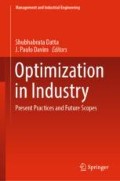Abstract
In this study, the implementation of evolutionary algorithms to the form-finding problem of masonry shell models is presented using Autoclaved Aerated Concrete material. Regarding the significance of design decisions, the study is focused on the conceptual stage of the design process. In this context, the applied method is addressed as multi-objective real-parameter constrained optimization . For the sake of dealing with the shell design problem, two objective functions are considered: minimization of global displacement and minimization of mass. Two multi-objective evolutionary algorithms , namely, Non-Dominated Sorting Genetic Algorithm II and Real-coded Genetic Algorithm with mutation strategy of Differential Evolution Algorithms are compared in terms of computational and architectural performance. As a result, the solutions generated by these algorithms are found much competitive.
Access this chapter
Tax calculation will be finalised at checkout
Purchases are for personal use only
References
Panozzo, D., Block, P., & Sorkine-Hornung, O. (2013). Designing unreinforced masonry models. ACM Transactions on Graphics (TOG), 32, 91.
Adriaenssens, S., Block, P., Veenendaal, D., & Williams, C. (2014). Shell structures for architecture: Form finding and optimization. Taylor & Francis.
Block, P., & Lachauer, L. (2011). Closest-fit, compressiononly solutions for free form shells. In IABSE/IASS London Symposium, International Association for Shell Spatial Structures.
Rippmann, M., Lachauer, L., & Block, P. (2012). Interactive vault design. International Journal of Space Structures, 27, 219–230.
Rippmann, M., & Block, P. (2013). Funicular shell design exploration. In ACADIA, Waterloo, Canada.
Narayanan, N., & Ramamurthy, K. (2000). Structure and properties of aerated concrete: A review. Cement & Concrete Composites, 22, 321–329.
Wittmann, F. H., & Balkema, A. (1992) Advances in autoclaved aerated concrete. Citeseer.
Brisch, J. H., Nelson, R. L., & Francis, H. L. (1999) Masonry: Materials, testing, and applications. American Society for Testing Materials.
Aroni, I. S. (1993). Autoclaved aerated concrete-properties, testing and design. CRC Press.
Pacheco-Torgal, F., Lourenc̦o, P. B., Labrincha, J., & Kumar, S. (2014). Eco-efficient masonry bricks and blocks: Design, properties and durability. Woodhead Publishing.
Preisinger, C., & Heimrath, M. (2014). Karamba—A toolkit for parametric structural design. Structural Engineering International, 24, 217–221.
Gulvanessian, H., Calgaro, J.-A., & Holický, M. (2002). Designer’s guide to EN 1990: Eurocode: Basis of structural design. Thomas Telford.
Becker, M., & Golay, P. (1999). Rhino NURBS 3D modeling. New Riders.
McNeel, R. (2009). Rhinoceros 3D (Vol. 15).
McNeel, R. (2013). Grasshopper 3D.
Sariyildiz, I. (2012, November 15–17). Performative computational design. In Keynote speech in: Proceedings of ICONARCH-I: International Congress of Architecture-I, Konya, Turkey.
Deb, K., Pratap, A., Agarwal, S., & Meyarivan, T. (2002). A fast and elitist multiobjective genetic algorithm: NSGA_II. IEEE Transactions on Evolutionary Computation, 6, 182–197.
Zitzler, E., Laumanns, M., & Thiele, L. (2001) SPEA2: Improving the strength Pareto evolutionary algorithm. In Eurogen, 2001 (pp. 95–100).
Cubukcuoglu, C., Chatzikonstantinou, I., Tasgetiren, M. F., Sariyildiz, I. S., & Pan, Q.-K. (2016). A multi-objective harmony search algorithm for sustainable design of floating settlements. Algorithms, 9, 51.
Ugurlu, C., Chatzikonstantinou, I., Sariyildiz, S., & Tasgetiren, M. F. (2015). Identification of sustainable designs for floating settlements using computational design techniques. In 2015 IEEE Congress on Evolutionary Computation (CEC) (pp. 2303–2310).
Ugurlu, C., Chatzikonstantinou, I., Sariyildiz, S., & Tasgetiren, M. F. (2015). Evolutionary computation for architectural design of restaurant layouts. In 2015 IEEE Congress on Evolutionary Computation (CEC) (pp. 2279–2286).
Goldberg, D. E. (2006). Genetic algorithms. Pearson Education India.
Brest, J., Greiner, S., Bošković, B., Mernik, M., & Zumer, V. (2006). Self-adapting control parameters in differential evolution: A comparative study on numerical benchmark problems. IEEE Transactions on Evolutionary Computation, 10, 646–657.
Bader, J., & Zitzler, E. (2011). HypE: An algorithm for fast hypervolume-based many-objective optimization. Evolutionary Computation, 19, 45–76.
Zitzler, E., & Thiele, L. (1999). Multiobjective evolutionary algorithms: a comparative case study and the strength Pareto approach. IEEE Transactions on Evolutionary Computation, 3, 257–271.
Jiang, S., Ong, Y.-S., Zhang, J., & Feng, L. (2014). Consistencies and contradictions of performance metrics in multiobjective optimization. IEEE Transactions on Cybernetics, 44, 2391–2404.
Delgarm, N., Sajadi, B., Delgarm, S., & Kowsary, F. (2016). A novel approach for the simulation-based optimization of the buildings energy consumption using NSGA-II: Case study in Iran. Energy and Buildings, 127, 552–560.
Delgarm, N., Sajadi, B., Kowsary, F., & Delgarm, S. (2016). Multi-objective optimization of the building energy performance: A simulation-based approach by means of particle swarm optimization (PSO). Applied Energy, 170, 293–303.
Wolpert, D. H., & Macready, W. G. (1997). No free lunch theorems for optimization. IEEE Transactions on Evolutionary Computation, 1, 67–82.
Acknowledgements
This work has been supported by Yasar University (YU) “Bilimsel Araştırma Projesi” (Scientific Research Project) with the grant number BAP-037. We would like to express our sincere gratitude to the scientific committee of YU.
Author information
Authors and Affiliations
Corresponding author
Editor information
Editors and Affiliations
Rights and permissions
Copyright information
© 2019 Springer Nature Switzerland AG
About this chapter
Cite this chapter
Cevizci, E., Kutucu, S., Morales-Beltran, M., Ekici, B., Fatih Tasgetiren, M. (2019). Structural Optimization for Masonry Shell Design Using Multi-objective Evolutionary Algorithms. In: Datta, S., Davim, J. (eds) Optimization in Industry. Management and Industrial Engineering. Springer, Cham. https://doi.org/10.1007/978-3-030-01641-8_5
Download citation
DOI: https://doi.org/10.1007/978-3-030-01641-8_5
Published:
Publisher Name: Springer, Cham
Print ISBN: 978-3-030-01640-1
Online ISBN: 978-3-030-01641-8
eBook Packages: EngineeringEngineering (R0)

